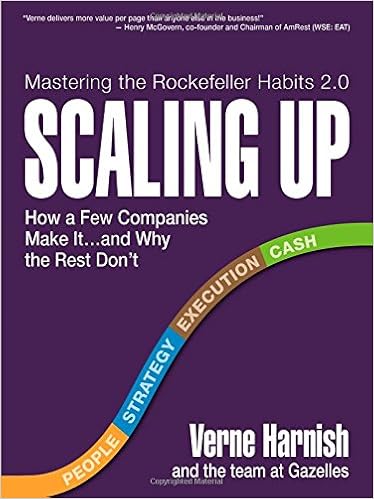Scaling Up Summary
3 min read ⌚
How a Few Companies Make It…and Why the Rest Don’t (Mastering the Rockefeller Habits 2.0)
“Scaling Up” is a guideline for growth.
Arm yourself with these useful tools, and spread your business successfully.
About Verne Harnish

Verne Varnish is an author, a columnist for fortune and the founder of Gazelles.
“Scaling Up Summary”
Why is it that so many companies are created over the years, and only a few of them become big game changers?
No matter how good your business is going and how superior your product is, the scaling process is an important part of the equation for success.
It seems that getting bigger does not make things easier.
On the contrary, it challenges you more.
So how do you go about the scaling up the process?
First, you need to make sure that you have the right people on board. Provide your staff with coaching, training, and create a culture of constant learning.
Second, find the point of balance between what your stakeholders demand and what your work demands.
Do not overlook the importance of the relationship you have with the stakeholders.
Third, build discipline, because, without it, you will not be able to implement your strategies.
Finally, start acting and making decisions on the most pressing questions.
First, take care of the biggest issues, and then continue to the smaller ones.
You can build these previously mentioned four D’s by focusing on your people, strategy, cash flows, and execution.
First, let’s talk about people.
Establishing communication among your employees is vital since information needs to flow among your teams and sub-teams.
Hence, if you feel that you are stuck in growth, review your team size and the current communication in your company.
Next, you need to establish a core purpose and core values of your company, as well as your goals for the next 20-25 years.
Only then you can build a successful strategy that focuses on the right markets and people.
To reach the goals fast, take the time to determine where your company’s biggest strengths are.
Once you have the strategy, keep the progress of execution in check.
Gather qualitative and quantitative data, develop a steady meeting routine, motivate employees to measure their daily performance, and gather customer feedback.
Finally, you have to understand cash flow and manage to create some cash reserves.
To expand your cash reserves use the cash conversion cycle (CCC). To simplify it, break it down into components: delivery, sales, production/inventory, billing/payment, and work with each of them separately.
Find ways to reduce the cycle and improve your overall business model.
Key Lessons from “Scaling Up”
1. The Elements of Discipline
2. Invest in Your People
3. Find Your Company’s Strengths
The Elements of Discipline
-
- Be aware of your priorities
-
- Organize regular meetings
- Review data constantly
Invest in Your People
It is important that you invest in your people and help them achieve their full potential.
You can do this by training, empowerment, simply listening to them, establishing core values and purpose, and setting clear goals and expectations.
Find Your Company’s Strengths
-
- Look into your customers’ minds
- Look at the x-factor that differentiates you from your rivals
Like this summary? We’d Like to invite you to download our free 12 min app, for more amazing summaries and audiobooks.
“Scaling Up” Quotes
There are no straight lines in nature or business. Share on X If the Core Values are the soul of the organization, the core Purpose (some call it “mission”) gives it heart. Share on X Letting go and trusting others to do things well is one of the more challenging aspects of being a leader of a growing organization. Share on X People join companies. They leave managers. Share on X Goals without routines are wishes; routines without goals are aimless. The most successful business leaders have a clear vision and the disciplines (routines) to make it a reality. Share on X
Emir is the Head of Marketing at 12min. In his spare time, he loves to meditate and play soccer.







